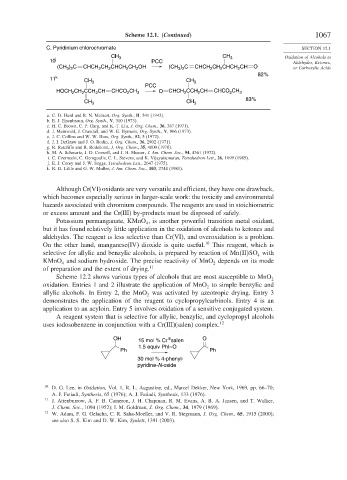Page 1091 - Advanced Organic Chemistry Part B - Reactions & Synthesis
P. 1091
Scheme 12.1. (Continued) 1067
C. Pyridinium chlorochromate SECTION 12.1
10 j CH 3 PCC CH 3 Oxidation of Alcohols to
Aldehydes, Ketones,
(CH 3 ) 2 C CHCH 2 CH 2 CHCH 2 CH 2 OH (CH 3 ) 2 C CHCH 2 CH 2 CHCH 2 CH O or Carboxylic Acids
82%
11 k CH 3 CH 3
PCC
HOCH CH CCH CH CHCO CH 3 O CHCH 2 CCH CH CHCO CH 3
2
2
2
2
2
2
83%
CH 3 CH 3
a. C. D. Hurd and R. N. Meinert, Org. Synth., II, 541 (1943).
b. E. J. Eisenbraun, Org. Synth., V, 310 (1973).
c. H. C. Brown, C. P. Garg, and K.-T. Liu, J. Org. Chem., 36, 387 (1971).
d. J. Meinwald, J. Crandall, and W. E. Hymans, Org. Synth., V, 866 (1973).
e. J. C. Collins and W. W. Hess, Org. Synth., 52, 5 (1972).
f. J. I. DeGraw and J. O. Rodin, J. Org. Chem., 36, 2902 (1971).
g. R. Ratcliffe and R. Rodehorst, J. Org. Chem., 35, 4000 (1970).
h. M. A. Schwartz, J. D. Crowell, and J. H. Musser, J. Am. Chem. Soc., 94, 4361 (1972).
i. C. Czernecki, C. Gerogoulis, C. L. Stevens, and K. Vijayakumaran, Tetrahedron Lett., 26, 1699 (1985).
j. E. J. Corey and J. W. Suggs, Tetrahedron Lett., 2647 (1975).
k. R. D. Little and G. W. Muller, J. Am. Chem. Soc., 103, 2744 (1981).
Although Cr(VI) oxidants are very versatile and efficient, they have one drawback,
which becomes especially serious in larger-scale work: the toxicity and environmental
hazards associated with chromium compounds. The reagents are used in stoichiometric
or excess amount and the Cr(III) by-products must be disposed of safely.
Potassium permanganate, KMnO , is another powerful transition metal oxidant,
4
but it has found relatively little application in the oxidation of alcohols to ketones and
aldehydes. The reagent is less selective than Cr(VI), and overoxidation is a problem.
On the other hand, manganese(IV) dioxide is quite useful. 10 This reagent, which is
selective for allylic and benzylic alcohols, is prepared by reaction of Mn II SO with
4
KMnO and sodium hydroxide. The precise reactivity of MnO depends on its mode
4 2
of preparation and the extent of drying. 11
Scheme 12.2 shows various types of alcohols that are most susceptible to MnO
2
oxidation. Entries 1 and 2 illustrate the application of MnO to simple benzylic and
2
allylic alcohols. In Entry 2, the MnO was activated by azeotropic drying. Entry 3
2
demonstrates the application of the reagent to cyclopropylcarbinols. Entry 4 is an
application to an acyloin. Entry 5 involves oxidation of a sensitive conjugated system.
A reagent system that is selective for allylic, benzylic, and cyclopropyl alcohols
uses iodosobenzene in conjunction with a Cr(III)(salen) complex. 12
OH 15 mol % Cr salen O
III
1.5 equiv PhI=O
Ph Ph
30 mol % 4-phenyl-
pyridine-N-oxide
10
D. G. Lee, in Oxidation, Vol. 1, R. L. Augustine, ed., Marcel Dekker, New York, 1969, pp. 66–70;
A. J. Fatiadi, Synthesis, 65 (1976); A. J. Fatiadi, Synthesis, 133 (1976).
11 J. Attenburrow, A. F. B. Cameron, J. H. Chapman, R. M. Evans, A. B. A. Jansen, and T. Walker,
J. Chem. Soc., 1094 (1952); I. M. Goldman, J. Org. Chem., 34, 1979 (1969).
12
W. Adam, F. G. Gelacha, C. R. Saha-Moeller, and V. R. Stegmann, J. Org. Chem., 65, 1915 (2000);
see also S. S. Kim and D. W. Kim, Synlett, 1391 (2003).

